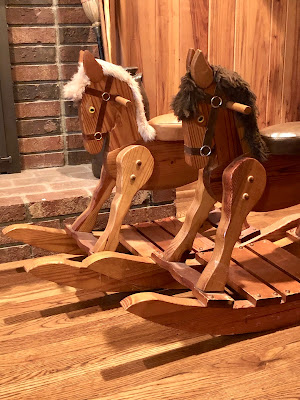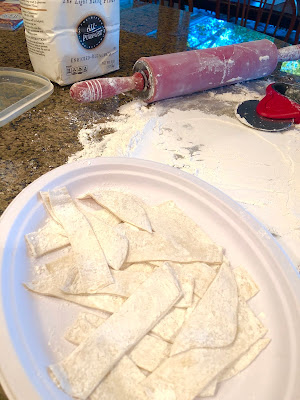It's that time of year again. I don't bake bread anymore year round. But I love to make it for Thanksgiving and Christmas. Last week I mixed up the starter as I get ready for baking season. The first batch of bread was good as always—one loaf eaten and two loaves stashed in the freezer. And this morning I stirred up another batch. Some of these early loaves will go to the church freezer. When folks go to visit homebound members they can take a loaf to give.
I've used this recipe for decades. It is not hard to bake. The hands-on time is not too much. Making the rising time fit into your schedule can be the tricky part. But if you spend a little time thinking about it, it will work. Daughter Jessica who works full-time has baked this bread for years. Maybe it could be a weekend baking project for you.
 |
| King Arthur Bread Flout |
First, use the right flour. This recipe specifies "bread flour." There IS a difference in flours. I now use King Arthur Bread Flour, but other brands also work. The difference is in the protein content. Bread flour has the highest protein content of the flours and that's what gives the good texture to the loaf.
 |
| White Lily All-Purpose Flour |
The flours I grew up with, like White Lily and Martha White and my mother's favorite Red Band, are made with soft wheat. Back in the day, southerners baked biscuits more often than yeast breads and the lower protein content in soft wheat flour made light, tender biscuits.
 |
| King Arthur All-Purpose |
If I am baking other yeast bread recipes, like
cinnamon rolls and
homemade dinner rolls, that call for
all-purpose flour I will use King Arthur All-Purpose. The soft wheat flours do not work well here. I know this from experience. It was a happy day when I figured out why we were having problems. I know there are other brands of hard wheat flours, but my store mostly stocks the southern soft wheat flours, so I stick with King Arthur when I need a hard wheat choice.
It takes five days to make the starter. I mixed mine up on a Thursday. Let it sit out for four days. I added yeast on a Monday, day #4, let it sit for 24 hours and then mixed my first bread on Tuesday. I even stuck a post-it on my starter to remind me when to add the yeast. I'm getting forgetful as the years go by. Either that, or I'm busier than I used to be.
My favorite storage container for the starter is a Cool Whip bowl. The lid of this plastic bowl is flexible and I cut in X into the top so the starter can breath. Other friends use a jar and leave the lid loose. (I think if I used a jar I would punch a few holes in the top like we used to do when catching lightening bugs.) The starter will pop the top off if it's tightly covered. It has happened.
Find the spot in your house that is the "rising spot." I put my dough on the kitchen counter with the under-the-counter lights turned on. Yes, I leave them on all night if the bread is rising at night. If I get in a hurry, I'll move the bowl closer to the lights. Make sure you don't turn the toaster oven on at this point! That's too much of a good thing.
If your house is cooler, the bread should still rise, but it might take longer. If I need to play around with my times and I need my bread to rise slower to fit my schedule, I'll put it on the kitchen island away from the lights. This is the kind of thing you have to figure out for yourself in your own house.
 |
| Pre-measured feeding ingredients. |
Here are some other tips:
*I am on the go now doing grandmother things, so sometimes Daddy-O is the one feeding the starter. I mix up bags of pre-measured sugar and potato flakes. He can dump this into the starter along with a cup of water. This makes it much easier for whichever of us feeds it. I use snack-size baggies for the feeding mix, then put all of them into a gallon-size zip bag for storage.
*See the recipe at the top of this photo? That's the same recipe I've used for over 20 years. I had it laminated all those years ago because I used it so often. It's the only recipe I've used enough to warrant a permanent copy but this has been great.
*I find it faster to mix the dough if I use a wire whisk when I stir in the first 3 cups of flour. Blends in a jiffy. Then I switch to a heavy spoon for the last 3 cups..
*Because I have one, I use a kitchen scale to weigh my dough when I divide it. Each portion of dough weighs about a pound. That way my three loaves are the same size. For many years in my "before I owned a kitchen scale" life, I eye-balled the thirds. And I was usually close. If one loaf was a little bigger, one lucky person just got a little more bread.
*The bread freezes beautifully. I can fit two loaves snugly in a gallon ziplock freezer bag. Then when I give it, I'll put a single loaf in a bread bag. If you get most of the air out of the freezer bag, it will keep quite a while. I think that because there is a little oil in this recipe, it holds better than more traditional yeast breads that dry out so quickly. FYI, I always date the bags going into the freezer so that I can use the older ones first.
*Just like there are choices of all-purpose flour, you have multiple options of yeast. For THIS recipe, I have always used an envelope of Fleishmann's ActiveDry Yeast Original. I have not tried the others, like RapidRise or bread machine instant yeast. Maybe they all will work but I don't know. I stick with the one I've always used.
*Last tip....take your rings off before you knead the dough. No need to be washing dough out of your rings.
I have shared the starter with friends and I get reports back that they made the dough by this recipe and then after loaf bread, they also made dinner rolls, cheese bread and cinnamon bread. I am such a creature of habit that I keep making basic loaves. But maybe this will be the year I venture out and get more creative.
SOURDOUGH BREAD
1 cup starter
1/4 cup sugar
1/4 cup oil
1-1/2 teaspoon salt
1-1/2 cups warm water
6 or more cups bread flour (use the extra to flour the surface for kneading)
Mix the bread ingredients. (I use a wire whisk to mix in the first 3 cups, then use a sturdy spoon for the rest.) Place in a large bowl, sprayed with PAM. Lightly spray the dough with PAM. Cover with plastic wrap. Let stand and rise at least 8 hours.
Punch down dough. Knead on floured board about 10 times. Divide into 3 parts. Spray three 8-inch loaf pans with PAM. Shape dough and place in pans. Cover loosely with plastic wrap. Let stand and rise until pans are full, about 5 to 6 hours.
Bake at 350 degrees for 30-40 minutes, or until brown and bottom of loaf sounds hollow when tapped. Cool on a wire rack.
Whole wheat bread: Use 2 cups whole wheat flour and 4 cups bread flour.
To feed starter: Remove 1 cup for baking (or discard) and feed with 1/3 cup sugar, 3 tbsp. instant potato flakes and 1 cup warm water. Mix well and let stand 8-12 hours. Then refrigerate. Store in plastic container with slits cut in lid. Feed every 3-7 days.
To make starter: Double the feeding recipe. Put in a glass or plastic container, loosely covered. Let set out on counter for 4 days. Then add 1 envelope dry yeast. (Not Rapid Rise) Let stand another 24 hours. Use 1 cup for first batch of bread or store in refrigerator for up to 7 days.
This bread freezes beautifully. It makes a great gift.
PS...If any of you local readers want starter, I'm happy to share.






























